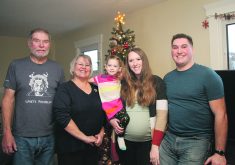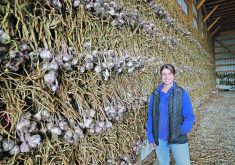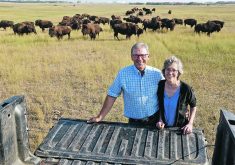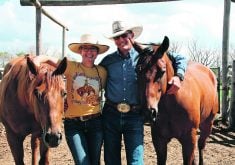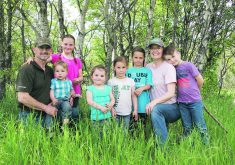Good herd management comes from a guiding set of principles and faith in hired workers, says Holstein producer
LYNDEN, Ont. —Travelling along a rural road near Lynden, Ont. recently, a writer looking for the Joe Loewith and Sons Holsteins farm stops at another farm looking for directions.
He’s farther down the road, the woman said before volunteering: “Good farmer.”
Indeed, sitting in a room with Ben Loewith, who runs the farm with his father, Carl, and his uncle, Dave, one is surrounded by plaques honouring the farm for many aspects of its operation, including numerous awards for herd management.
Good herd management comes, Loewith said, from meticulous attention to details, dedicated adherence to a guiding set of principles and faith in good farm workers who are offered opportunities to set out their work.
Such focus pays off in results, he said.
“We’re in the middle of July; if we can make it to the end of August without losing a calf, then we’ll have gone the entire year without losing a calf.… (That) would be a phenomenal goal for us to hit,” considering the industry average is almost 10 percent calf mortality younger than two months.
The farm milks 410 cows a day and has about 850 animals, including dry cows and young stock.
There are six full-time staff. Ben’s wife, Jennifer Howe, is a television producer, and their children, Madeline, 14, and William, 11, feed the calves on weekends and after school.
Read Also

Nutritious pork packed with vitamins, essential minerals
Recipes for pork
Despite growing up on the farm, Loewith wasn’t destined to be a farmer. “I didn’t particularly like doing chores in high school,” he said. “When I was in high school I told my father that if I end up coming home to the farm, it means a whole lot of things have gone wrong in my life.”
But after three years working in management positions near Toronto, he returned to the farm in 1999.
“My father and my uncle were doing a new expansion on the operation … so I asked them if I could come home for a six monthstrial period, and if at the end of the six months, if they decided that wasn’t working out, I would leave with no questions asked and no hard feelings.
“The six months came and went and nobody seemed to say anything, so as near as I can tell I’m still on probation.”
At the front of the barn — built in 2015 to mitigate heat with fans and an attic — is a five-point mission statement that focuses on product quality, animal welfare, staff development, environmental concerns and community support.
“Seeing that statement — that idea that we’re going to meet the needs of the cow every day — (means) animal welfare will be of paramount importance,” Loewith said.
“Sometimes, at the end of a difficult 14-hour day, it’s easy to convince yourself that this animal, her issues will keep until tomorrow morning when I have a little more help to assist me in dealing with her. For me, that’s not a very important day in my life, but for that animal, that’s probably the most important day of the year in her life because how I treat that cow and how I interact with that cow is going to impact the next 364 days of her lactation.”
To that end, he relies on workers to help with decision-making. “ If I can give those people autonomy — whether it’s genetics, whether it’s cattle sales, whether it’s raising calves, whether it’s maintenance, whether it’s the agronomy on the field — if someone shows a passion for that, I am more than happy to give them autonomy over that area and give them control.
“It’s very much a win-win. They feel that they have some control and some autonomy in their job and it takes a whole area of the operation off my plate.”
That doesn’t mean people operate with isolated responsibilities.
“As much as different people have different areas of expertise that they’re in charge of, I still want everybody to be able to do every job on the farm.”
And each person must understand why the protocols are in place so they can make better individual choices, Loewith said.
“(For example), we want fresh feed in front of the cows when they come back from the milking parlour, and I want a calf to get her colostrum fed within half an hour. If someone’s by themselves working in the barn, there might come a situation where they have to choose between those two things.… If they know why those protocols are in place, then they can make an educated decision on which of those I’m going to choose.”
Loewith relies on a good relationship with advisers, including a veterinarian, nutritionist and genetic adviser.
“We take their advice extremely seriously,” he said.
“It’s too easy to fall into a trap to say, ‘well, I understand what you’re saying but that’s not going to work on our farm for the following reasons.’ I think a lot of advisers get incredibly frustrated with their clients because of that.”
He also is meticulous with collecting and analyzing data.
“We make an effort to record absolutely everything that happens to every cow,” he said. “Then we can go back and analyze that data. If things start to get better, we can say, ‘when did things start to get better, what changes did we make that allowed things to get better?’ ”
Data management also helps with animal health.
“If there’s a health issue that’s affecting the herd, if I’ve entered the data … I can break it down to say it’s actually not a herd-wide event, it’s a subset of my herd that’s being affected by this issue and the only way you can analyze that data is if you’re religiously recording all those events and everything that’s going on on the farm.”
Loweith is prepared when the subject of supply management comes up. Canada’s quota system allows producers of dairy, poultry and eggs quotas guaranteed prices. Critics say this is costly to consumers.
“What supply management does is it controls the division of the consumer dollar between the retailer, the processors and the producers,” he said. “It redistributes that consumer dollar more equitably.
“People who are calling for a free market in dairy industry, I think they’re basing it more on a philosophical economic argument.… I think it all boils down to the ideology that an open market is always better for the consumer, and we’ll ignore any other factors whatsoever — that if we can get rid of tariffs, if we can get rid of regulation, it will be better for everybody, and I think quite frankly that’s a childish way of looking at it.
“I find it shocking that someone can look at that system in the United States or the subsidies in the European Union and say, ‘this is what we should be modelling our system after.’ ”
To help the public understand agriculture, the Loewith farm annually hosts tours, which typically draw about 1,200 people.







